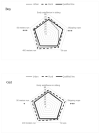Nutritional status, food consumption, lifestyle, and physical fitness in rural and urban elementary school children in Northeast China
- PMID: 36407515
- PMCID: PMC9667101
- DOI: 10.3389/fnut.2022.1044877
Nutritional status, food consumption, lifestyle, and physical fitness in rural and urban elementary school children in Northeast China
Abstract
Childhood obesity is observed not only in developed countries but also in some developing countries in Asia, where low physical activity and poor physical fitness have been reported. The primary goal of weight loss is to reduce body fat mass, thereby reducing the risk of metabolic syndrome. Unfortunately, a concomitant decrease in lean mass, including muscle mass, is often observed when weight is lost. This study aimed to clarify the nutritional status and physical fitness of local elementary school children and to investigate the factors associated with nutritional status. This study evaluated measures that can reduce the tendency toward obesity and recommends exercise that can reduce weight while maintaining or increasing muscle strength. A total of 911 elementary school children were recruited for this study. All the participants completed anthropometric measurements, dietary surveys, and physical fitness tests. Compared with the Chinese obesity criteria, the proportions of obese and overweight subjects were generally high [22 (rural girls) to 47% (urban boys)], and urban children had a higher obesity rate than rural children. Overall, rural children had better physical fitness test results than urban children did. Skipping rope was correlated with muscle mass. Exercise time (β = -0.31, p < 0.01), skipping rope (β = -0.25, p < 0.01), screen time (β= 0.23, p < 0.01); sit-ups (β = -0.20, p < 0.01); 400-m run (β = -0.19, p < 0.01); urban or rural area (β = 0.18, p < 0.01); oil intake (β = 0.15, p < 0.01), family income (β = 0.11, p < 0.05); and sex (β = -0.10, p < 0.05) were significant predictive factors for overweight and obesity, respectively. The diet of schoolchildren can be improved by reducing the intake of grain and edible oils. Physical fitness of schoolchildren can be improved by increasing exercise time and selecting exercises with higher metabolic equivalents. Rope skipping appears to be the best option because it can ameliorate obesity by increasing muscle strength. The results of this study can provide a reference for the development of obesity intervention methods for children in China and worldwide.
Keywords: China; food consumption; nutritional status; obesity; physical fitness.
Copyright © 2022 Liu, Liu, Wang, Yan and Hao.
Conflict of interest statement
The authors declare that the research was conducted in the absence of any commercial or financial relationships that could be construed as potential conflicts of interest.
Figures
Similar articles
-
The effectiveness of web-based programs on the reduction of childhood obesity in school-aged children: A systematic review.JBI Libr Syst Rev. 2012;10(42 Suppl):1-14. doi: 10.11124/jbisrir-2012-248. JBI Libr Syst Rev. 2012. PMID: 27820152
-
Trends in physical fitness, growth, and nutritional status of Chinese children and adolescents: a retrospective analysis of 1·5 million students from six successive national surveys between 1985 and 2014.Lancet Child Adolesc Health. 2019 Dec;3(12):871-880. doi: 10.1016/S2352-4642(19)30302-5. Epub 2019 Sep 30. Lancet Child Adolesc Health. 2019. PMID: 31582349
-
Dietary behaviors, physical activity and sedentary lifestyle associated with overweight and obesity, and their socio-demographic correlates, among Pakistani primary school children.Int J Behav Nutr Phys Act. 2011 Nov 25;8:130. doi: 10.1186/1479-5868-8-130. Int J Behav Nutr Phys Act. 2011. PMID: 22117626 Free PMC article.
-
[Simple obesity in children. A study on the role of nutritional factors].Med Wieku Rozwoj. 2006 Jan-Mar;10(1):3-191. Med Wieku Rozwoj. 2006. PMID: 16733288 Review. Polish.
-
Offspring body size and metabolic profile - effects of lifestyle intervention in obese pregnant women.Dan Med J. 2014 Jul;61(7):B4893. Dan Med J. 2014. PMID: 25123127 Review.
Cited by
-
Association between nutritional status, body composition, and fitness level of adolescents in physical education in Casablanca, Morocco.Front Nutr. 2023 Nov 7;10:1268369. doi: 10.3389/fnut.2023.1268369. eCollection 2023. Front Nutr. 2023. PMID: 38024348 Free PMC article.
-
The relationship between body dissatisfaction, lifestyle, and nutritional status among university students in Southern China.BMC Psychiatry. 2023 Sep 30;23(1):705. doi: 10.1186/s12888-023-05215-8. BMC Psychiatry. 2023. PMID: 37777718 Free PMC article.
-
Associations of sugar-sweetened beverage consumption and screen time with physical fitness index: a multicentre cross-sectional study among Chinese adolescents.BMC Public Health. 2024 Sep 28;24(1):2656. doi: 10.1186/s12889-024-20158-9. BMC Public Health. 2024. PMID: 39342150 Free PMC article.
-
Differences in nutritional status and level of physical activity among adolescents living in urban and rural areas of Montenegro - national study.BMC Public Health. 2024 Mar 26;24(1):896. doi: 10.1186/s12889-024-18402-3. BMC Public Health. 2024. PMID: 38532385 Free PMC article.
References
-
- Abarca-Gómez L, Abdeen ZA, Hamid ZA, Abu-Rmeileh NM, Acosta-Cazares B, Acuin C, et al. . Worldwide trends in body-mass index, underweight, overweight, and obesity from 1975 to 2016: a pooled analysis of 2416 population-based measurement studies in 128. 9 million children, adolescents, and adults. Lancet. (2017) 390:2627–42. 10.1016/S0140-6736(17)32129-3 - DOI - PMC - PubMed
-
- Zhu Z, Tang Y, Zhuang J, Liu Y, Wu X, Cai Y, et al. . Physical activity, screen viewing time, and overweight/obesity among Chinese children and adolescents: an update from the 2017 physical activity and fitness in China-the youth study. BMC Public Health. (2019) 19:197. 10.1186/s12889-019-6515-9 - DOI - PMC - PubMed
LinkOut - more resources
Full Text Sources


